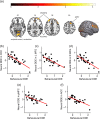The date/delay effect in intertemporal choice: A combined fMRI and eye-tracking study
- PMID: 38401135
- PMCID: PMC10893971
- DOI: 10.1002/hbm.26585
The date/delay effect in intertemporal choice: A combined fMRI and eye-tracking study
Abstract
Temporal discounting, the tendency to devalue future rewards as a function of delay until receipt, is influenced by time framing. Specifically, discount rates are shallower when the time at which the reward is received is presented as a date (date condition; e.g., June 8, 2023) rather than in delay units (delay condition; e.g., 30 days), which is commonly referred to as the date/delay effect. However, the cognitive and neural mechanisms of this effect are not well understood. Here, we examined the date/delay effect by analysing combined fMRI and eye-tracking data of N = 31 participants completing a temporal discounting task in both a delay and a date condition. The results confirmed the date/delay effect and revealed that the date condition led to higher fixation durations on time attributes and to higher activity in precuneus/PCC and angular gyrus, that is, areas previously associated with episodic thinking. Additionally, participants made more comparative eye movements in the date compared to the delay condition. A lower date/delay effect was associated with higher prefrontal activity in the date > delay contrast, suggesting that higher control or arithmetic operations may reduce the date/delay effect. Our findings are in line with hypotheses positing that the date condition is associated with differential time estimation and the use of more comparative as opposed to integrative choice strategies. Specifically, higher activity in memory-related brain areas suggests that the date condition leads to higher perceived proximity of delayed rewards, while higher frontal activity (middle/superior frontal gyrus, posterior medial frontal cortex, cingulate) in participants with a lower date/delay effect suggests that the effect is particularly pronounced in participants avoiding complex arithmetic operations in the date condition.
Keywords: date/delay effect; episodic thinking; eye-tracking; fMRI; precuneus; temporal discounting.
© 2024 The Authors. Human Brain Mapping published by Wiley Periodicals LLC.
Conflict of interest statement
The authors declare that they have no conflict of interest.
Figures





Similar articles
-
Attentional mechanisms of the date/delay effect in intertemporal choice: An eye-tracking study.J Exp Psychol Learn Mem Cogn. 2025 May;51(5):737-754. doi: 10.1037/xlm0001363. Epub 2024 Jun 20. J Exp Psychol Learn Mem Cogn. 2025. PMID: 38900547
-
Episodic Tags Enhance Striatal Valuation Signals during Temporal Discounting in pathological Gamblers.eNeuro. 2017 Jun 13;4(3):ENEURO.0159-17.2017. doi: 10.1523/ENEURO.0159-17.2017. eCollection 2017 May-Jun. eNeuro. 2017. PMID: 28612049 Free PMC article.
-
Cueing the personal future to reduce discounting in intertemporal choice: Is episodic prospection necessary?Hippocampus. 2015 Apr;25(4):432-43. doi: 10.1002/hipo.22431. Epub 2015 Mar 11. Hippocampus. 2015. PMID: 25676022
-
The neural basis of delay discounting: A review and preliminary model.Neurosci Biobehav Rev. 2017 Aug;79:48-65. doi: 10.1016/j.neubiorev.2017.04.022. Epub 2017 Apr 29. Neurosci Biobehav Rev. 2017. PMID: 28465167 Review.
-
Neuronal correlates of delay discounting in healthy subjects and its implication for addiction: an ALE meta-analysis study.Am J Drug Alcohol Abuse. 2019;45(1):51-66. doi: 10.1080/00952990.2018.1557675. Epub 2019 Jan 11. Am J Drug Alcohol Abuse. 2019. PMID: 30632802
Cited by
-
The effect of time on delay discounting in younger and older adults.Aust J Psychol. 2024 Dec 12;77(1):2438704. doi: 10.1080/00049530.2024.2438704. eCollection 2025. Aust J Psychol. 2024. PMID: 40666222 Free PMC article.
References
-
- Ackenheil, M. , Stotz‐Ingenlath, G. , Dietz‐Bauer, R. , & Vossen, A. (1999). MINI international neuropsychiatric interview. In German Version 5.0.0, DSM IV. Psychiatrische Universitätsklinik München.
-
- Amlung, M. , Marsden, E. , Holshausen, K. , Morris, V. , Patel, H. , Vedelago, L. , Naish, K. R. , Reed, D. D. , & McCabe, R. E. (2019). Delay discounting as a transdiagnostic process in psychiatric disorders: A meta‐analysis. JAMA Psychiatry, 76(11), 1176–1186. 10.1001/jamapsychiatry.2019.2102 - DOI - PMC - PubMed
MeSH terms
Grants and funding
LinkOut - more resources
Full Text Sources

